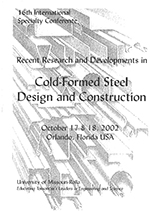Session Dates
17 Oct 2002
Abstract
This paper presents the details of a new innovative cold-formed steel building system that has no conventional frames, purlins or girts. As this building system uses a new structural system, the load paths and structural behaviour are unknown, therefore, full-scale testing is essential. A series of full-scale tests of a 5.4 m x 5.4 m cold-formed steel building subjected to simulated wind loads was conducted. The results have shown that in its present state, this new building system is not adequate for its intended purpose and optimisation is required. To achieve this optimisation, analytical modelling will be used. To date, a number of finite element models have been created to simulate the behaviour of the test building. The details and results of these models are presented in this paper.
Department(s)
Civil, Architectural and Environmental Engineering
Research Center/Lab(s)
Wei-Wen Yu Center for Cold-Formed Steel Structures
Meeting Name
16th International Specialty Conference on Cold-Formed Steel Structures
Publisher
University of Missouri--Rolla
Document Version
Final Version
Rights
© 2002 University of Missouri--Rolla, All rights reserved.
Document Type
Article - Conference proceedings
File Type
text
Language
English
Recommended Citation
Darcy, Greg and Mahendran, Mahen, "Numerical and Experimental Studies of an Innovative Cold-formed Steel Building System" (2002). CCFSS Proceedings of International Specialty Conference on Cold-Formed Steel Structures (1971 - 2018). 4.
https://scholarsmine.mst.edu/isccss/16iccfss/16iccfss-session8/4
Numerical and Experimental Studies of an Innovative Cold-formed Steel Building System
This paper presents the details of a new innovative cold-formed steel building system that has no conventional frames, purlins or girts. As this building system uses a new structural system, the load paths and structural behaviour are unknown, therefore, full-scale testing is essential. A series of full-scale tests of a 5.4 m x 5.4 m cold-formed steel building subjected to simulated wind loads was conducted. The results have shown that in its present state, this new building system is not adequate for its intended purpose and optimisation is required. To achieve this optimisation, analytical modelling will be used. To date, a number of finite element models have been created to simulate the behaviour of the test building. The details and results of these models are presented in this paper.



